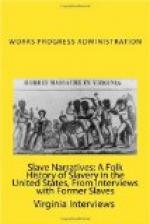SCHOOLING
I did not get much schooling. Between the time I was old enough to go to school and the time I went to the field, I got a little. I would go to school from July to September, and also about six weeks in January.
They had public school taught by some of the people. I went to a white man once. An old white woman taught there before him. I went to a Negro woman, Old Lady Abbie Lindsay. She lives here now down on State Street. She is about ninety years old. I went to Jube Williams (white), Current Lewis, Abbie Lindsay, and A.G. Mertin. They did n’t paas you by grades then. I got through the fourth reader. If you got through, they would go back and carry you through again. They had the old Blue Back Speller. I got ready for the fifth reader but I quit. I had just begun to cipher, in arithmetic, but I had to quit because they could n’t spare me out of the field. In fact they put me into the field when I was eight years old, but I managed to go to school until I was about twelve years old or something like that. I never got a year’s schooling all put together. My mother was a widow and had five or six children, none of them able or big enough to work but my oldest sister. She raised five of us.
If I had done as she told me, I might have been a good scholar. But I played around and went off with the other children. I learnt way afterwards when I was grown how to write my name. I could work addition and I could work some in multiplication, but I couldn’t work division and couldn’t work subtraction. Come around any time, specially on Sunday afternoons.
Name of Interviewer: Velma Sample Subject: NEGRO LORE—THE STORY OF CASIE JONES BROWN
Casie Jones Brown was a dearly loved Negro servant. He was known for his loving kindness toward children, both black and white. Lots of the white children would say, “Casie sure is smart” because Casie was a funny and witty old darkie. Casie has a log house close to his master, Mr. Brown. They live on what is called the Brown Plantation. The yard had large old cedars planted all around it. They were planted almost a century ago. The plantation is about six miles from Paragould, [TR: possibly Baragould] Arkansas, where the hills are almost mountains. There have been four generations living in the old house. They have the big sand stone fireplaces. Casie has a spiritual power that makes him see and hear things. He says that sometimes he can hear sweet voices somewhere in his fireplace. In the winter time he does all of his cooking in a big black kettle with three legs on it, or a big iron skillet. And when he first settled there he did not have a stove to cook on except the fireplace. He says the singing that comes from somewhere about the fireplace is God having his angels entertain him in his lonely hours. Casie is 91 years old and has been in that settlement as long as he can remember.




